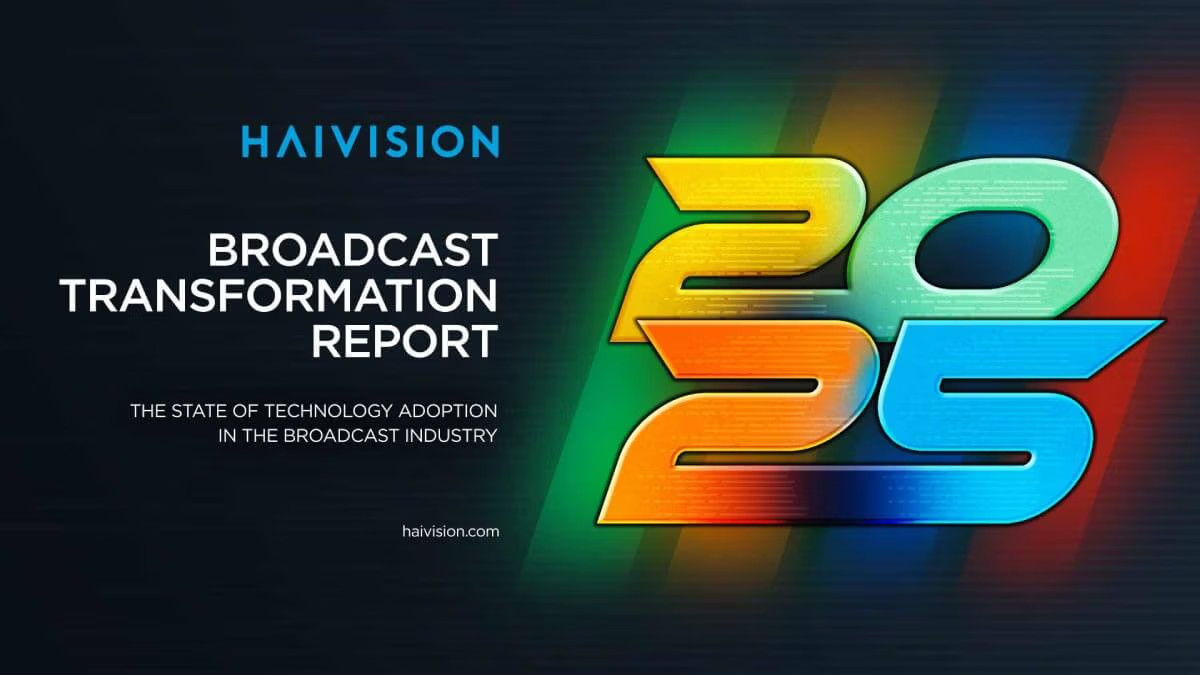Key Takeaways from Haivision’s 2025 Broadcast Transformation Report

Haivision’s sixth annual Broadcast Transformation Report offers an in-depth look at the technology trends driving the future of broadcasting. Based on insights from nearly 900 broadcast professionals across 110 countries, the report highlights how the industry is adopting new solutions to improve efficiency, scalability, and production quality.
The 2025 report identifies five major industry shifts: SRT’s growing dominance, the rise of 5G, AI-powered automation, hybrid cloud workflows, and the continued growth of HEVC.
SRT Adoption Soars, Widening the Gap with RTMP

The Emmy-Award winning SRT (Secure Reliable Transport), invented and open-sourced by Haivision, continues to be the most widely used live video transport protocol, with adoption growing from 68% in 2024 to 77% in 2025. This increase reinforces SRT’s role as the protocol of choice for delivering secure, low-latency video over IP networks.
RTMP ranked second, with 58% of respondents using the protocol, followed by UDP Unicast/Multicast in third at 44%. Additionally, 35% of respondents selected cellular bonding solutions, a new transport protocol category in this year’s report.
Demand for Efficiency Fuels 5G Usage

The adoption of 5G for live video contribution continues to grow, with 76% of broadcasters using cellular networks already leveraging 5G. This underscores the increasing reliance on 5G’s enhanced bandwidth, lower latency, and cost efficiencies to support live production workflows.
Among respondents using cellular networks for live video contribution:
- 68% use both 3G/4G/LTE and 5G
- 24% rely solely on 3G/4G/LTE networks
- Only 8% use 5G exclusively
These findings highlight the industry’s gradual transition toward full 5G adoption, with many broadcasters still utilizing a mix of legacy and next-generation cellular technologies.
As the demand for higher-quality, real-time video production increases, 5G’s ability to deliver greater bandwidth and lower latency is driving its growing adoption across the broadcast industry.
Broadcasters Accelerate AI Adoption

AI-powered solutions are gaining traction across the industry, with 25% of respondents now integrating AI into their workflows—a substantial increase from just 9% in 2024.
Key applications of AI include:
- Efficiency and productivity gains through automation (45%)
- Automated translation and closed captioning (42%)
- Content creation (36%)
When we asked respondents which three technologies will have the biggest impact on broadcast production in the next five years, 64% of respondents identified AI and Machine Learning as likely to be the most transformative.
Hybrid On-Premise and Cloud Usage Becomes Mainstream

Cloud adoption remains prevalent, with 86% of respondents using cloud-based workflows in some capacity. However, full cloud migration remains limited—49% of respondents rely on cloud for less than a quarter of their workflows, up from 43% in 2024. This underscores the continued reliance on on-premise infrastructure for critical broadcast operations.
When asked about their cloud usage:
- 49% use cloud for less than 25% of their workflows
- 18% use it for 25%-50%
- 14% do not use cloud at all
- 11% leverage cloud for 50%-75% of their workflows
- 6% use cloud for more than 75%
- 2% have fully cloud-based workflows
Despite increased cloud adoption, budget constraints (48%) and network reliability concerns (37%) remain the biggest obstacles to full-scale cloud transitions. As a result, hybrid workflows combining cloud and on-premise solutions remain the industry standard for broadcasters looking to balance flexibility, control, and cost efficiency.
HEVC catches up with H.264

For each year that we have produced this report, H.264 has emerged as the most used video codec, and 2025 is no different, with 79% of respondents leveraging it. HEVC usage has steadily increased over the years, rising from 50% in 2021 to 70% in 2025, and is now firmly established as the second most common codec.
Methodology and Demographics
The 2025 Broadcast Transformation Report is based on a global survey conducted between November and December 2024, gathering insights from nearly 900 broadcast professionals. The survey participants represent a diverse range of organizations and roles, offering a comprehensive snapshot of the current broadcast landscape.

